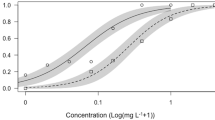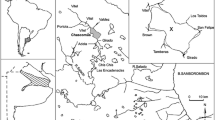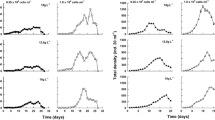Abstract
Tolerance to low oxygen concentrations is expected in Brachionus plicatilis, a rotifer adapted to live in saline warm waters. The population dynamics of a clone of this species, isolated from an endorreic saline lake, was studied under controlled laboratory conditions. Although their growth and metabolism is extremely reduced, B. plicatilis populations are able to maintain relatively high-density populations (a mean of 35 ind ml−1) in oxygen concentrations below 1 mg 1−1, for more than one month. Major features of population growth related to oxygen are discussed.
Similar content being viewed by others
References
Edmondson, W. T., 1965. Reproductive rate of planktonic rotifers as related to food and temperature in nature. Ecol. Monogr. 35: 61–111.
Epp, R. W. & P. W. Winston, 1978. The effect of salinity and pH on the activity and oxygen consumption of Brachionus plicatilis. Comp. Biochem. Physiol. 59A: 9–12.
Esparcia, A. & M. Serra, 1988. Efecto del alimento tratado térmicamente en el crecimiento poblacional de Brachionus plicatilis Müller 1786 (Rotifera: Brachonidae). Inv. Pesq. 52: 345–353.
Gäde, G., 1984. Effects of oxygen deprivation during anoxia and muscular work on the energy metabolism of the crayfish Orconetes limosus. Comp. Biochem. Physiol. 77A: 495–502.
Galkovskaya, G. A., 1987. Plancktonic rotifers and temperature. Hydrobiologia 147: 307–317.
Hochachka, P. W., 1986. Defense strategies against hypoxia and hypothermia. Science 231: 234–241.
Hofmann, W., 1977. The influence of abiotic environmental factors on population dynamics in planktonic rotifers. Arch. Hydrobiol. Beih. 8: 77–83.
Ito, T., 1960. On the culture of mixohaline rotifer Brachionus plicatilis O. F. Müller in the sea water. Rep. Fac. Fish. prefect. Univ. Mie. 3: 708–740.
Larsson, P., 1971. Vertical distribution of planktonic rotifers in a meromictic lake, Blankvatn near Oslo, Norway. Norwerg. J. Zool. 19: 47–75.
Miracle, M. R., 1976. Distribución en el espacio y en el tiempo de las especies del zooplancton del lago de Banyoles. Instituto Nacional para la Conservación de la Naturaleza. (Ministerio de Agricultura). Monografias 5, Madrid 270 pp.
Miracle, R. & E. Vicente, 1983. Vertical distribution and rotifer concentrations in the chemocline of meromictic lakes. Hydrobiologia 104: 259–267.
Pejler, B., 1975. Taxonomical and ecological studies on planktonic Rotatoria from Northern Swedish Lappland. Kungl. Svensk. Vetensk. Handl. 6(5): 1–68.
Pourriot, R., 1965. Recherches sur l'écologie des rotifères. Supplement 21 a ‘Vie et milieu’. Masson, Paris. 224 pp.
Pourriot, R. & M. Deluzarches, 1970. Sur la consommation d'oxigene par les rotiferes. Ann. Limnol. 6: 229–248.
Ruttner-Kolisko, A., 1972. Der Einfluss von Temperatur und Salzgehalt des Mediums auf Stoffweschsel-und Vermehrungs-intensität von Brachionus plicatilis (Rotatoria). Dt. Zool. Ges. 65: 89–95.
Ruttner-Kolisko, A., 1974. Plankton rotifers. Biology and taxonomy. Biennengewässer 26, 146 pp.
Ruttner-Kolisko, A., 1980. The abundance and distribution of Filinia terminalis in various types of lakes as related to temperature, oxygen, and food. Hydrobiologia 73: 169–175.
Schlüter, M., 1980.Mass culture experiments with Brachionus rubens. Hydrobiologia 73: 45–50.
Serra, M. & M. R. Miracle, 1983. Biometric analysis of Brachionus plicatifs ecotypes from spanish lagoons. Hydrobiologia 104: 279–291.
Serra, M., 1987. Variabilidad morfológica, isoenzimática y demográfica en poblaciones de Brachionus plicatilis. Diferenciación genética y plasticidad fenotípica. Tesis doctoral. Universidad de Valencia.
Swift, M. C. & U. T. Hammer, 1979. Zooplankton population dynamics and Diaptomus production in Waldsea lake, a saline ‘meromictic’ lake in Saskatchewan. J. Fish. Res. Bd Can. 36: 1431–1438.
Walker, K. F., 1981. A synopsis of ecological information on the saline lake rotifer Brachionus plicatilis O. F. Müller 1786. Hydrobiologia 81: 159–167.
Zwaan, A. De & T. C. M. Wijsman, 1976. Anaerobic metabolism in bivalvia (Mollusca). Characteristics of anaerobic metabolism. Comp. Biochem. Physiol. 54B: 313–324.
Author information
Authors and Affiliations
Rights and permissions
About this article
Cite this article
Esparcia, A., Miracle, M.R. & Serra, M. Brachionus plicatilis tolerance to low oxygen concentrations. Hydrobiologia 186, 331–337 (1989). https://doi.org/10.1007/BF00048929
Issue Date:
DOI: https://doi.org/10.1007/BF00048929




